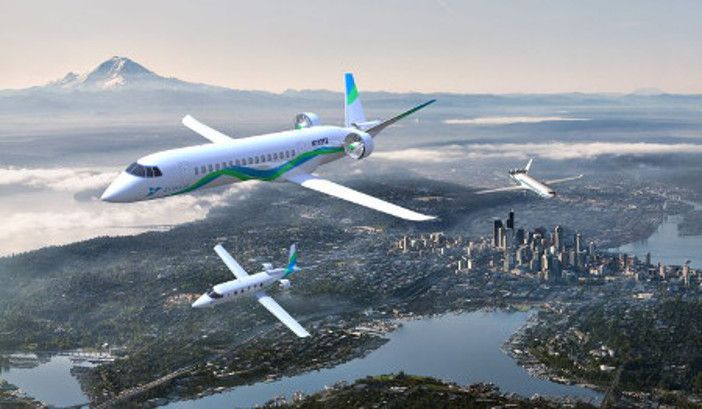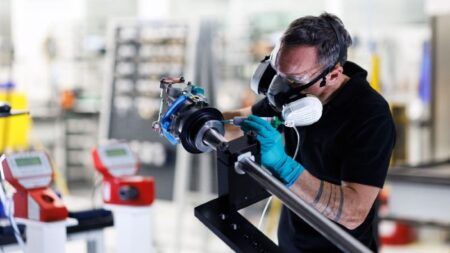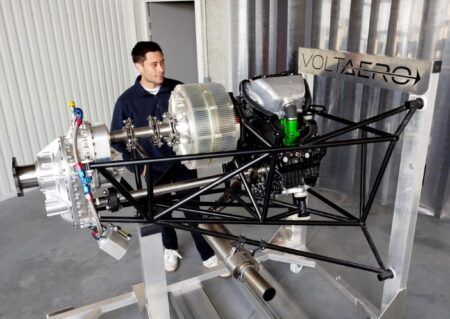Hybrid and electric propulsion technology is being developed to reduce the environmental impact of aircraft (Image: Zunum Aero)
It’s early days right now for large-scale electric and hybrid aircraft, but the potential is huge. There are a lot of different areas of the aircraft that can be electrified, and the potential gains in terms of efficiency, reliability and sustainability are massive.
Commercial transportation aircraft such as the Boeing 787, the Airbus A350 and the Bombardier C-Series in the last two years are leading the way in showing the benefits of electrification. The first areas include braking and actuation systems, where engineers are swapping out hydraulic systems with electrical ones and realizing increased reliability.
Yet there are many challenges that engineers developing more electric aircraft and aero-engines still have to overcome. Standardization has a vital role to play in this development process and the introduction of more electrical systems in air vehicles.
Why standardize?
SAE International has a portfolio of just over 10,000 standards, three-quarters of which are for the aerospace sector covering performance requirements, material specifications, industry recommended practices and information reports for everything from quality and safety to fiber-optic cabling, to data interoperability and prognostics.
There are several reasons we create technology standards and the process of electrifying aircraft will benefit from increased standardization. Commercially, standards support industry cohesion, cut barriers and lower costs through common supply chains. They can be called out directly in contracts as requirements or preferences. Standards also enable interoperability, so platforms can have different characteristics but still fit together – an essential part of the electrification of aircraft.
One other important reason for standardization is safety and the associated regulatory approval. With the aviation regulatory bodies increasingly using SAE and industry standards to support performance-based regulation, the standards that industry creates form part of aviation safety. Although voluntary, standards may be used as “acceptable means of compliance” and the consensus work on electrical systems, higher voltage, and materials can provide a high level of reassurance to certifying authorities.
Innovation
Standardization therefore is a sign of the progressiveness of industry and authorities. Working in a standardization environment early-on for new technology concepts such as electrification is a good idea: it helps industry by providing a good baseline from which companies develop a technology with certification and supply chain in mind.
However, there is also a balance that has to be achieved between standardization and innovation, in a way that innovation is not stifled. That balance changes as a technology, such as electrification of aircraft, goes up the Technology Readiness Levels. The experts on SAE International’s committees that are driving the development of electrical standards are sensitive to this need not to stifle innovation.
Material needs for electrical systems
The SAE AE-9 committee is focused on writing standards and specifications for electrical materials, including consideration for permanent magnet corrosion, soft magnetic aging and capacitor materials and behavior, and addressing appropriate materials at the nanoscale. The development of such materials is being driven by a requirement for more advanced materials that are better suited to electrical transmission in aircraft.
Legacy aerospace materials may not behave optimally with the kind of high-powered applications in aircraft that engineers are targeting for more electric aircraft (MEA) and engines (MEE), and aerospace-specific considerations for the operating environment, such as high temperature and altitude, must be given for aerospace electrical components and systems.
The approach to developing the standards is bottom-up from the expert engineers themselves, such as in the AE-9 committee. It’s also allied to strategic input from the SAE Electric Aircraft Steering Group. Aspects under consideration include when and where a technology or product reaches an appropriate level of maturity, the need for interoperability, and when and where a supply chain needs to be created.
Industry participation
Standards have an important role to play in the electrification and the door is open for all interested parties to become involved. Input from all stakeholders is encouraged: operators and airlines, MROs, designers, manufacturers, and test and certification engineers. Their advice and support will further determine the direction of electrical standards for aircraft.
We are connecting engineers all over the world with these standards and their development. Not only are committee meetings great places to network with peers from around the world, the development of standards also has a tangible and important benefit for the companies they represent.
These electrical standards are being developed for the benefit of industry, by industry. I’d urge anyone with a contribution to get involved by contacting me at my email address.
David Alexander has been with SAE International and its affiliates for 11 years and assumed the role of Director, Aerospace Standards May 2016, In this role, David is responsible globally for the operation of the SAE Aerospace Standards program and its staff, the management support for the SAE Aerospace Council and for liaisons with key organisations around the world.





